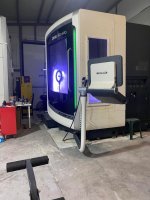GeorgiMirov
Plastic
- Joined
- Jan 28, 2020
Hello ,
I recently bought an used DMU EVO 60 2015 with iTNC 530.
The machine had a lot of hours on it ( 38000) but I got it for a good deal.
Everything is working , there are no errors and it's overall a working machine.
I've decided to change the probe stylus with a smaller one ( 3mm ) and when I recalibrated it for diameter it showed weird numbers on the screen ( attached picture ).
When I measure the ball with a digital micrometer it shows 2.98mm.
After the calibration the control calls it R 1.41 in the offset page and also in the calibration page. So it basically measures it 2.82mm with 2microns offset on X and 0,078mm offset in Y.
I've adjusted the runout of the tip to be around 1 micron ( needle of the 2micron indicator barely moves).
Another issue :
Removing material with adaptive strategy around a plastic cylindrical stock , and the cutter starts to chatter when it reaches Y+ and Y- strokes , and no chatter when in position X+ and X- strokes.
When jogging the machine in Y direction with more than 30% rapids( moving the hole column ) it shakes the machine. No such observations in X and Z.
I suspect a major wear on the Y axis ballscrew/nut. Any other suggestions ?
I recently bought an used DMU EVO 60 2015 with iTNC 530.
The machine had a lot of hours on it ( 38000) but I got it for a good deal.
Everything is working , there are no errors and it's overall a working machine.
I've decided to change the probe stylus with a smaller one ( 3mm ) and when I recalibrated it for diameter it showed weird numbers on the screen ( attached picture ).
When I measure the ball with a digital micrometer it shows 2.98mm.
After the calibration the control calls it R 1.41 in the offset page and also in the calibration page. So it basically measures it 2.82mm with 2microns offset on X and 0,078mm offset in Y.
I've adjusted the runout of the tip to be around 1 micron ( needle of the 2micron indicator barely moves).
Another issue :
Removing material with adaptive strategy around a plastic cylindrical stock , and the cutter starts to chatter when it reaches Y+ and Y- strokes , and no chatter when in position X+ and X- strokes.
When jogging the machine in Y direction with more than 30% rapids( moving the hole column ) it shakes the machine. No such observations in X and Z.
I suspect a major wear on the Y axis ballscrew/nut. Any other suggestions ?



